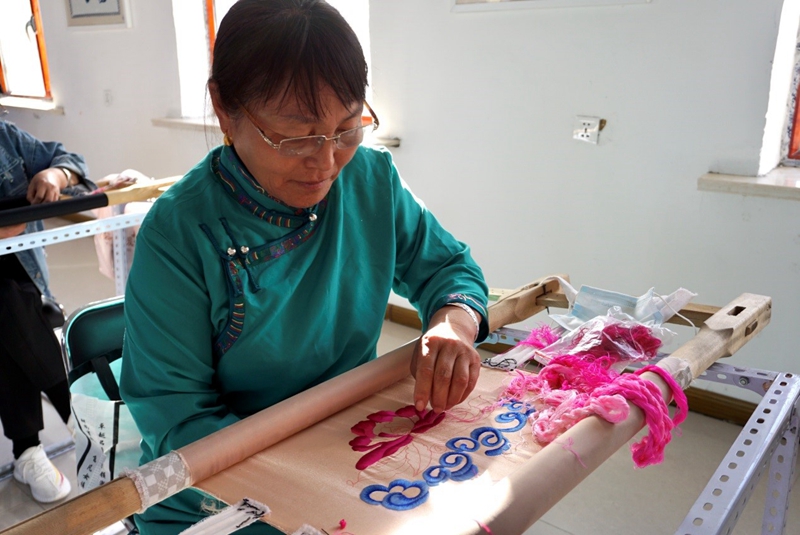Moving toward sustainability and prosperity in Inner Mongolia (2)
 |
| A Mongolian woman is working in an embroidery workshop in Horqin Right Wing Middle Banner. (People’s Daily/Wang Di) |
Recently, more than 160 calves were born in Honggelbatel’s Modern Joint Family Ecological Ranch, which will bring him an annual income of approximately 2 million yuan ($310,794).
Honggelbatel, a herdsman from Zarut Banner, China’s Inner Mongolia Autonomous Region, runs a family ecological ranch together with his brother and sister, which was gradually developed into a demonstration base for grassland ecological restoration in Horqin district.
In 2014, the joint ranch had more than 1,000 sheep and 300 cattle. However, the increase in the number of livestock also led to pressure on the pastures and the severe decline of the grassland ecology. Faced with the dual pressure of protecting the grassland and increasing income, Zarut Banner began to implement a policy of reducing sheep and increasing cattle.
While other herders were still waiting to see, Honggelbatel made up his mind to sell all of his sheep. He adopted measures such as scientific livestock breeding, grassland grazing, and breed improvement. He also began to shift toward eco-tourism.
“Sheep eat a lot of grass and shave grass roots, but cows eat the tip, which will not affect the growth of the grass. The same grassland, different pressure. I used to raise more sheep, and it took nearly a million yuan to buy forage. Under the guidance of the government and experts, we continue to improve the breeds, to raise fewer but better cattle, which not only improves economic efficiency but also protects the ecological environment,” Honggelbatel said.
“Living a happy life is the primary human right,” as President Xi Jinping pointed out in his congratulatory letter to the symposium marking the 70th anniversary of the Universal Declaration of Human Rights. China embraces a human rights philosophy that centers on the people, and regards the rights to subsistence and development as the basic human right of paramount importance.
Contrary to the unfounded allegations in Western media in recent years, the facts in the Inner Mongolia Autonomous Region show that the cause of human rights in China has made headway on all fronts. Several measures proved that the Inner Mongolia Autonomous Region has been fully committed to implementing China’s Human Rights Action Plan from 2016 to 2020, respecting and safeguarding the rights of ethnic minorities to use and develop their own cultures and languages, and protecting and caring for the rights of disadvantaged groups.
Nowadays, the family ecological ranch of Honggelbatel is continuously expanding, with modern facilities readily available. Relying on beautiful natural scenery and transportation advantages, Honggelbatel has built several yurts on the ranch and started a pastoral tourism industry, receiving thousands of tourists every year. He took the initiative to provide stable jobs for the surrounding poor households and lead them to improve their lives together.
The Mongolian herder Hein helps out on the ranch from May to October every year during the peak tourist season. With the help of the government’s poverty alleviation policy, he moved from an earthen house to the new building, and now he has a stable job. “Thanks to the good policies of CPC and government, there is nothing to worry about in my life,” Hein said.
At the same time, ethnic Mongolian women are more confident while their living conditions are improved and their own cultural characteristics are vigorously promoted.
Since participating in Mongolian embroidery skills training organized by the Horqin Right Wing Middle Banner government, Liu Menglan’s embroidery had increased the family’s income by about 20,000 yuan per year. In 2017, Liu Menglan started learning Mongolian embroidery, and has now become a first-level embroiderer. She has taught more than 70 apprentices.
In 2019, Liu’s family has been completely lifted out of poverty. “In the past, dry days caused poor harvests, life was sad and difficult. In recent years, with the help of the government, we moved into a new house and learned new skills. My husband has been hired as a forest ranger,” Liu said. “I am living a happy life out of my past expectation.. Every day is full of hope. If there is any dissatisfaction, I would say, it will be better to learn embroidery earlier!”
Today, nearly 30,000 women in Xing’an League, North China’s Inner Mongolia Autonomous Region, have gathered to learn and pass on Inner Mongolia’s intangible cultural heritage like embroidery and paper cutting.
“The greatest benefit of the promotion of Mongolian intangible cultural heritage by the government is that it has improved production methods in rural areas that have been dominated by male labor for a long time. Now, more women can participate in the economic development and cultural revitalization of their hometown,” said Bai Jingying, director of the Standing Committee of the Horqin Right Wing Middle Banner People’s Congress and leader of a Mongolian embroidery group.
 |  |
Photos
Related Stories
- Models present creations designed by students of Inner Mongolia Arts University
- Workers stationed in China's Inner Mongolia for railway sand control
- Snow covers Sumu Mountain in north China's Inner Mongolia
- Coronavirus found in Inner Mongolia hospital
- Autumn scenery in Ordos, Inner Mongolia
- Kubuqi Desert in north China turns green thanks to efforts of local people
- China introduces first Chinese-Mongolian legal dictionary
- Handicraft making provides working opportunities to poverty-stricken people in Inner Mongolia
- Inner Mongolia to hold ethnic culture and sports night market
- Former senior official of Inner Mongolia prosecuted for bribery
Copyright © 2021 People's Daily Online. All Rights Reserved.










